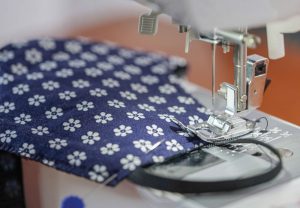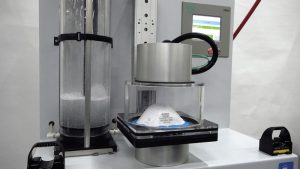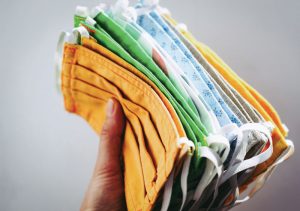
sewers, responded to the need for
barrier face coverings.
Standardized testing of face coverings may be beneficial in reducing public confusion and misinformation about performance.
By Dr. Davis Lee; Dr. Erin Kirkpatrick; Dr. Emily Fitzharris; Dr. Ariana Levitt; Michael Posson, M.P.H., CIH; Ryan Siskey M.S.; and Dr. Mark Roberts
During the pandemic, there has been a sharp increase in demand for face coverings to reduce the risk of infection by the novel coronavirus (SARS-CoV-2), creating both opportunity and challenge for textile manufacturers. As a result, there is growing awareness that a clear regulatory difference exists between personal protective equipment (PPE) used in an occupational or healthcare setting — N95 respirators and surgical masks for example — and barrier face coverings that may be used by the general public such as the face coverings as described by the Centers for Disease Control and Prevention (CDC).1 While established standards and requirements already exist for many types of PPE, this was not the case for the barrier face coverings that have been in wide-use by the general public in response to the COVID-19 pandemic.2
The textile community responded to the need for barrier face coverings in unprecedented fashion. This has in turn driven the need for standardized testing to help educate the public and to reduce confusion about performance. Many universities, companies and testing laboratories have developed novel approaches for evaluating the efficacy of barrier face coverings, with particular emphasis on inexpensive and easy to implement methods. Standardized methods for evaluating face covering efficacy have also emerged. ASTM F3502-213 for example, was developed and published in just eight months in response to the critical need for objective test methods. The purpose was to provide a test method that evaluates the ability of a face covering to act as a barrier to the transfer of aerosolized particles and large droplets of saliva and/or mucus, while also being reasonably comfortable to the wearer.4 The evaluation places a focus on the filtration efficiency, breathability, fit and expected usage conditions.5
This article reviews the importance of standardized test methods, and some of the key issues related to face coverings. At the same time, it should be noted that even with standardized testing to quantify performance, individual use factors — such as wearing the mask correctly, facial fit, usage time and other factors — also impact the efficacy of the barrier covering performance. These factors are beyond the scope of this article.
Why Test Standards Are Needed
The increased use of face coverings during the COVID-19 pandemic led to a surge of studies on the filtration efficacy of various face coverings and materials. In September of 2020, a paper was published detailing a “simple optical measurement method” using an expanded laser beam and a cell phone camera to evaluate the efficacy of different masks.6 The study examined a variety of samples and ranked the relative droplet count emerging from the coverings. The study authors concluded that “speaking through some masks — particularly the neck gaiter — seemed to disperse the largest droplets” causing an increase in droplet count compared to the “no mask” control. The authors concluded that smaller droplets dispersed from larger droplets remained airborne for longer periods of time, suggesting that the use of neck gaiters may be counterproductive to the wearer. Even though limitations of the detection method were discussed in the article, many news outlets reported on the implication that in some cases, a neck gaiter may be worse than no mask at all.7,8,9,10
These media conclusions have since been disproven by a number of different studies showing that neck gaiters can be effective at blocking a range of particle sizes, especially when worn as a double layer.11,12 Moreover, the higher number of particles detected in the initial study have led some to speculate that this was the result of fibers shedding from the fabric.13 However, even with these new results, the controversy of “Gaitergate” left the public confused over the efficacy of face covering options during a time when supply chain constraints were making it necessary for the general public to use all available options.

chloride aerosol testing.
Key Issues
Efforts to evaluate the performance of textile face coverings — for filtration efficiency and breathability, for example — have shed light on the importance of standardizing the methods used to evaluate these coverings. Standardized methods for evaluating face masks help to ensure the availability of consistent methodologies for comparing barrier face covering technologies. They also help to assess the various parameters that can affect both performance results and variability.
The following points represent examples of product and test parameters that can affect the performance results of barrier face coverings:
- Textile Construction: Numerous studies have shown that fiber content and fabric structure can significantly impact filtration efficiency and breathability.14,15,16 For example, researchers compared the performance of two cotton samples with different weave densities, or threads per inch (TPI), and found that the denser weave had a higher filtration efficiency.17 While this is not surprising, many studies do not describe the structure and fiber content of textile coverings, making it difficult to interpret the results and compare the results within and between studies. The new ASTM F3502-21 requires the primary materials of construction, including the materials and fiber content to be printed legibly on the product packaging.
- Sample Conditioning: It is common practice to pre-condition textile samples to minimize test variability. This is done by pre-conditioning test samples to a standard humidity and temperature for a prescribed period of time prior to testing. ASTM F3502-21 requires pre-conditioning test samples at 85 ± 5% relative humidity and 38 ± 2.5°C for 25 ± 1 hour.18,19 This is particularly important for textile face coverings, as temperature and humidity may influence the performance of substrate materials — such as polyester, nylon or cotton — differently.
- Air Flow Rate: Air flow rate has been shown to affect the measured efficiency of textile face coverings. A slower flow rate typically results in improved filtration efficiencies.20,21 Ideally, the test flow rate should be standardized and should mimic respiratory rates so that test results are realistic. Pressure drop across the textile face covering is a related parameter that can affect both filtration efficiencies and breathability. ASTM F3502-21 specifies a flow rate of 85 + 4 liters per minute, and if the sample is lying flat in a filter holder adjusting the flow rate to achieve a face velocity of 10 + 0.5 centimeters per second.22
- Mask Fit: In use, mask fit is critical to the overall performance of the textile face covering as gaps between the wearer’s face and the textile allow respiratory droplets and aerosols to escape.23,24 Quantifying and standardizing mask fit is especially challenging and is often not sufficiently examined. ASTM F3502-21 addresses the importance of mask fit with a leakage assessment that is described in the method. The standard also permits supplemental quantitative testing to determine the leakage ratio based on ASTM F3407: Standard Test Method for Respirator Fit Capability for Negative-Pressure Half-Facepiece Particulate Respirators.25
- Charge Neutralizing Aerosol Particles: Charged particles can impact filtration efficiency due to electrostatic interactions with the mask material and other nearby particles.26,27,28 For instance, aerosols that contain moisture can change diameter during testing, influencing the measured particle size distribution of the filtered particles and the filtration efficiency.29,30 In order to mitigate these effects, particles need to be charge neutralized and dried prior to testing. This is a common practice used in standards evaluating filtration efficiency, such as EN 182231, ISO 2946332, ASTM F3502-2133, and NIOSH No. TEB-APR-STP-0059.34

homemade masks, may help reduce public confusion and
misinformation about performance.
Conclusions
While test methods for evaluating the efficacy of PPE face masks have existed for years, they are only just emerging for barrier face coverings. Standardized testing may be beneficial in helping to reduce public confusion and misinformation about performance. Standardized tests, such as ASTM F3502-21 that address key technical issues, such as the few examples identified in this article should provide both manufacturers and consumers with increased clarity on the performance of face coverings.
References:
1 “Recommendation Regarding the Use of Cloth Face Coverings, Especially in Areas of Significant Community-Based Transmission” Centers for Disease Control and Prevention, reviewed 3 April 2020, www.cdc.gov/coronavirus/2019-ncov/prevent-getting-sick/cloth-face-cover.html. Accessed 21 April 2020.
2 “Global Collaboration to Advance Personal Protective Equipment (PPE) Safety, Quality, and Innovation” ASTM White Paper, February 2021, https://www.astm.org/ABOUT/PPE-White-Paper-R2.pdf. Accessed 25 May 2021.
3 ASTM F3502-21, Standard Specification for Barrier Face Coverings, ASTM International, West Conshohocken, PA, 2021, www.astm.org.
4 Plotz, Chris, INDA, Director of Education & Technical Affairs, personal communication.
5 Peachman, Rachel. “New Standards for Everyday Masks will Help People Pick Covid-19 Face Coverings.” The Washington Post, 1 March 2021. https://www.washingtonpost.com/health/new-covid-19-cloth-mask-standards/2021/02/26/307aa398-730e-11eb-85fa-e0ccb3660358_story.html. Accessed 25 May 2021.
6 Fischer, Emma, et al. “Low-Cost Measurement of Face Mask Efficacy for Filtering Expelled Droplets During Speech.” Science Advances, 2 September 2020. 10.1126/sciadv.abd3083.
7 Morris, Emily. “Facial Masks that Miss the Mark.” The Oakland Post, 17 February 2021. https://oaklandpostonline.com/34628/opinion/facial-masks-that-miss-the-mark/. Accessed 25 May 2021.
88 Kelleher, Suzanne. “Neck Gaiters Do Not Curb COVID-19, Study Finds.” Forbes, 11 August 2020. https://www.forbes.com/sites/suzannerowankelleher/2020/08/11/neck-gaiters-do-not-curb-covid-19-study-finds/?sh=5086abdd204d. Accessed 25 May 2021.
9 Chiu, Allyson. “Wearing a Neck Gaiter May Be Worse Than No Mask At All, Researchers Find.” The Washington Post, 11 August 2020. https://www.washingtonpost.com/lifestyle/wellness/mask-test-duke-covid/2020/08/10/4f2bb888-db18-11ea-b205-ff838e15a9a6_story.html. Accessed 25 May 2021.
10 Baskar, Pranav. “How Should I Cover My Face? A Deeper Look Into Neck Gaiters and Face Shields.” NPR, 14 August 2020. https://www.npr.org/sections/goatsandsoda/2020/08/14/902244060/how-should-i-cover-my-face-a-deeper-look-into-neck-gaiters-and-face-shields. Accessed 25 May 2021.
<em11 Pan, Jin and Marr, Linsey. “Neck Gaiters.” Civil and Environmental Engineering, Virginia Tech, 15 August 2020. https://drive.google.com/file/d/1GNXt-SWSsPTp8nv0MtqpvUmVQI8g-7WE/view. Accessed 25 May 2021.
12 Lindsley, William, et al. “Efficacy of Face Masks, Neck Gaiters and Face Shields for Reducing the Expulsion of Simulated Cough-Generated Aerosols.” Aerosol Science and Technology, 7 January 2021. 10.1080/02786826.2020.1862409.
13 https://twitter.com/CappaSnappa/status/1296494910355451905
14 Konda, Abhiteja, et al. “Aerosol Filtration Efficiency of Common Fabrics Used in Respiratory Cloth Masks.” ACS Nano, 24 April 2020, 10.1021/acsnano.0c03252.
15 Zhao, Mervin, et al. “Household Materials Selection for Homemade Cloth Face Coverings and their Filtration Efficiency Enhancement with Triboelectric Charging.” Nano Letters, 2 June 2020. 10.1021/acs.nanolett.0c02211.
16 Zangmeister, Christopher, et al. “Filtration Efficiencies of Nanoscale Aerosol by Cloth Mask Materials Used to Slow the Spread of SARS-CoV-2.” ACS Nano, 25 June 2020. 10.1021/acsnano.0c05025.
17 Konda, Abhiteja, et al. “Aerosol Filtration Efficiency of Common Fabrics Used in Respiratory Cloth Masks.” ACS Nano, 24 April 2020, 10.1021/acsnano.0c03252.
18 ASTM D1776-04, Standard Practice for Conditioning and Testing Textiles, ASTM International, West Conshohocken, PA, 2021, www.astm.org.
19 ASTM F3502-21. See ASTM F3502-21, Standard Specification for Barrier Face Coverings, ASTM International, West Conshohocken, PA, 2021, www.astm.org.
20 Kumar, Amit, et al. “Evaluation of Filtration Efficacy of Various Types of Facemasks Using Ambient and PAO Aerosols Following with Different Sterilization Methods.” MedRxIv, 27 October 2020. 10.1101/2020.10.23.20218073.
21 Stevens, Gregory and Moyer, Ernest. “’Worst Case’ Aerosol Testing Parameters: I. Sodium Chloride and Dioctyl Phthalate Aerosol Filter Efficiency as a Function of Particle Size and Flow Rate.” American Industrial Hygiene Association Journal, May 1989.
22 See ASTM F3502-21, Standard Specification for Barrier Face Coverings, ASTM International, West Conshohocken, PA, 2021, www.astm.org.
23 Aydin, Onur, et al. “Performance of fabrics for home-made masks against the spread of COVID-19 through droplets: A quantitative mechanistic study.” Extreme Mechanics Letters, 11 August 2020. 10.1016/j.eml.2020.100924.
24 Zhao, Mervin, et al. “Household Materials Selection for Homemade Cloth Face Coverings and their Filtration Efficiency Enhancement with Triboelectric Charging.” Nano Letters, 2 June 2020. 10.1021/acs.nanolett.0c02211.
25 ASTM F3407-20, Standard Test Method for Respirator Fit Capability for Negative-Pressure Half-Facepiece Particulate Respirators, ASTM International, West Conshohocken, PA, 2020, www.astm.org.
<sup26 Rule, Ana et al. “Comment on Aerosol Filtration Efficiency of Common Fabrics Used in Respiratory Cloth Masks: Questioning Their Findings. ACS Nano, 22 September 2020. 10.1021/acsnano.0c05265.
27 Freitag, Steffen et al. “Why simple face masks are unexpectedly efficient in reducing viral aerosol transmissions.” MedRxIv, 4 December 2020. 10.1101/2020.12.03.20243063.
28 Mueller, Amy et al. “Quantitative Method for Comparative Assessment of Particle Removal Efficiency of Fabric Masks as Alternative to Standard Surgical Masks for PPE.” Matter, 2 September 2020. 10.1016/j.matt.2020.07.006.
29 Rule, Ana et al. “Comment on Aerosol Filtration Efficiency of Common Fabrics Used in Respiratory Cloth Masks: Questioning Their Findings. ACS Nano, 22 September 2020. 10.1021/acsnano.0c05265.
30 Mueller, Amy et al. “Quantitative Method for Comparative Assessment of Particle Removal Efficiency of Fabric Masks as Alternative to Standard Surgical Masks for PPE.” Matter, 2 September 2020. 10.1016/j.matt.2020.07.006.
31 EN 1822: High Efficiency Air Filters (Efficient Air Filters (EPA), High Efficiency Air Filters (HEPA), Ultra Low Penetration Air Filters (ULPA)). ICS 13.040.40. 14 January 2019.
32 ISO 29463: High-Efficiency Filters and Filter Media for Removing Particles in Air, September 2017, www.iso.org.
33 ASTM F3502-21, Standard Specification for Barrier Face Coverings, ASTM International, West Conshohocken, PA, 2021, www.astm.org.
34 National Institute for Occupational Safety and Health. “Determination of Particulate Filter Efficiency Level for N95 Series Filters Against Solid Particulates for Non-Powered, Air-Purifying Respirators.” NIOSH Procedure No. TEB-APR-STP-0059, Rev. 3.2, 13 December 2019.
Editor’s Note: Dr. Davis Lee is senior managing scientist, Dr. Erin Kirkpatrick is managing scientist, Dr. Emily Fitzharris is associate and Dr. Ariana Levitt is a scientist in the Polymer Science & Materials Chemistry practice of Exponent Inc. — a multi-disciplinary engineering and scientific consulting firm. Ryan Siskey, M.S., is the principal and office director of Exponent’s Biomedical Engineering & Sciences practice. Michael Posson, M.P.H., CIH, is senior managing scientist and Dr. Mark Roberts is principal scientist at Exponent’s Health Sciences practice.
July/August 2021




